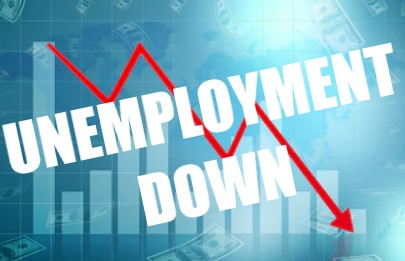
SPRINGFIELD – The Illinois Department of Employment Security (IDES) announced today that the unemployment rate fell -3.6 percentage points to 6.8 percent, while nonfarm payrolls were about unchanged, down -1,100 jobs in October, based on preliminary data provided by the U.S. Bureau of Labor Statistics (BLS) and released by IDES. The September monthly decrease in payrolls was revised from the preliminary report, from -12,000 to -9,200 jobs. The September unemployment rate was revised upward from the preliminary report, from 10.2 percent to 10.4 percent.
The October payroll jobs estimate and unemployment rate reflects activity for the week including the 12th. The BLS has published FAQs for the October payroll jobs and the unemployment rate.
The state’s unemployment rate was -0.1 percentage point lower than the national unemployment rate reported for October, which was 6.9 percent, down -1.0 percentage point from the previous month. The Illinois unemployment rate was up +3.1 percentage points from a year ago when it was 3.7 percent.
In October, the three industry sectors with the largest over-the-month gains in employment were: Professional and Business Services (+13,800), Construction (+4,200) and Trade, Transportation and Utilities (+2,100). The industry sectors that reported the largest payroll declines were: Government (-13,500), Educational and Health Services (-6,500) and Information (-1,500).
“While the unemployment rate has steadily declined over the last several months, the governor’s office and IDES are working tirelessly to assist claimants while confronting the challenges created by the Covid-19 pandemic,” said Deputy Governor Dan Hynes. “IDES is taking necessary steps to make claimants aware of the impending expiration to the federal CARES Act programs, set to end the week ending December 26. The department is working closely with the Pritzker administration to advocate for claimant stability at the federal level and will continue to do so throughout this pandemic.”
“While we continue to see positive signs that employment is picking back up, we know that there is much more work ahead as we strive for a full recovery from the impact of COVID-19 on our Illinois workers and Illinois businesses,” said Erin Guthrie, Director of the Department of Commerce and Economic Opportunity (DCEO). “Under the leadership of Governor Pritzker, Illinois has not only led with a swift and decisive public health response to the virus, but we’ve also introduced more than $1 billion in economic support programs at DCEO alone to help small businesses and communities weather the storm. Our continued vigilance on public health measures is necessary to restore our economy and bring more people back to work.”
Compared to a year ago, nonfarm payroll employment decreased by -411,800 jobs, with losses across all major industries. The industry groups with the largest jobs decreases were: Leisure and Hospitality (-129,000), Professional and Business Services (-64,800) and Educational and Health Services (-59,600). Illinois nonfarm payrolls were down -6.7 percent over-the-year as compared to the nation’s -6.1 percent over-the-year decline in October.
The number of unemployed workers declined sharply from the prior month, a -35.5 percent decrease to 425,900 but was up +80.3 percent over the same month for the prior year. The labor force was down -1.7 percent over-the-month and down -3.1 percent over-the-year. The unemployment rate identifies those individuals who are out of work and seeking employment. An individual who exhausts or is ineligible for benefits is still reflected in the unemployment rate if they actively seek work.
In May, Governor Pritzker launched Get Hired Illinois, a new one-stop-shop website to help connect job seekers with hiring employers in real time. The site features virtual job fairs, no-cost virtual training, and includes Illinois Job Link (IJL), the state’s largest job search engine, which recently showed 54,682 posted resumes with 93,659 available jobs.
Seasonally Adjusted Unemployment Rates
Illinois Seasonally Adjusted Nonfarm Jobs – by Major Industry
• 2015-2019 seasonally adjusted labor force data for Illinois, and all other states, have been revised as required by the U.S. Bureau of Labor Statistics (BLS). The monthly historical revisions to state labor force estimates reflect new national benchmark controls, state working-age population controls, seasonal factors, as well as updated total nonfarm jobs and unemployment benefits claims inputs. Illinois labor force data were also smoothed to eliminate large monthly changes as a result of volatility in the monthly Census Population Survey (CPS) and national benchmarking. For these reasons, the comments and tables citing unemployment rates in previous news releases/materials may no longer be valid.
• Monthly seasonally adjusted unemployment rates for Illinois and the Chicago-Naperville-Arlington Heights Metropolitan Division are available here.
• Monthly 2011-2019 seasonally adjusted nonfarm payroll employment data for Illinois have been revised. To control for potential survey error, the estimates are benchmarked annually to universal counts derived primarily from unemployment insurance tax reports.
• Not seasonally adjusted jobs data with industry detail are available here. “Other Services” include activities in three broad categories: personal and laundry; repair and maintenance; and religious, grant making, civic and professional organizations. Seasonally adjusted data for subsectors within industries are not available.
About the Department of Employment Security
The Illinois Department of Employment Security (IDES) provides vital employment services to Illinois workers, employers, and job seekers with resources including Job Fairs and Illinois Job Link, analyzes and disseminates actionable Labor Market Information, and administers the Unemployment Insurance Program. To see the full range of services provided by IDES, and for the latest news concerning the department, visit IDES.Illinois.gov.













